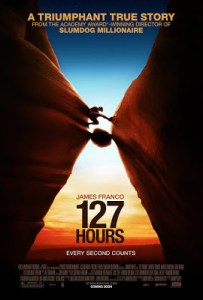Not for the faint-of-heart, but Boyle mostly succeeds in taking a true story with the thinnest plot and making it fairly exciting.
Dir. Danny Boyle
2010 | UK/USA | Adventure/Biography/Drama | 94 mins | 1.85:1 | English
NC16 (passed clean) for language and some disturbing violent content/bloody images
Cast: James Franco, Amber Tamblyn, Kate Mara
Plot: A mountain climber becomes trapped under a boulder while canyoneering alone near Moab, Utah, and resorts to desperate measures in order to survive.
Awards: Nom. for 6 Oscars – Best Picture, Best Leading Actor, Best Adapted Screenplay, Best Film Editing, Best Original Score, Best Original Song.
Distributor: 20th Century Fox
Accessibility Index
Subject Matter: Moderate
Narrative Style: Slightly Complex
Pace: Normal
Audience Type: Slightly Mainstream

(Reviewed in theatres – first published on 27 Jan 2011)
Spoilers: Yes
With a plot this minimalist, one could forgive director Danny Boyle if he had made a 10-minute short instead of a 90-minute feature length film about a guy who went hitchhiking and got his right arm crushed in between a rock wall and a huge boulder deep in a crevice of a remote canyon.
Based on an incredible true story, 127 Hours is a visual recount of the ordeal an immobile Aron Ralston went through for five days… before he decided to cut off his entire arm with a cheap penknife and escape to freedom.
James Franco plays Ralston in a mostly one-man show that exhibits wit, self-depreciating humor, determination, and the will to survive. To his credit, Franco manages to pull everything off quite remarkably despite being stuck in one spot for nearly the entire film.
Much like Ryan Reynolds in Buried (2010), a claustrophobic horror film about one man’s predicament of being buried alive in a coffin, Franco’s character earns our sympathy not because his situation is extremely dire, but because he is unlucky to land in such a predicament that is of no fault of his.
He has a camcorder with him, and Boyle uses this device of his to design sequences that add much needed humor and the occasional (false) optimism to the film to positively weaken the seriousness of the film’s subject matter.
There are only a limited number of angles a director can choose to shoot such a film, but Boyle’s trademark hyper-kinetic visual style allows him to venture into areas that are uncommon even in mainstream cinema, let alone in films of this strange new sub-genre – for instance, the exaggerated psychology of the protagonist, and the visual-aural parallelization of certain actions in the climax of the film.
“Don’t lose it. Aron, do not lose it.”
Boyle explores the mental state of Ralston through sequences of dreams, nightmares, and premonitions – scenes that would be more at home in a fantasy or horror film, but surprisingly works well in a realist film like 127 Hours.
Of course, the overwhelming use of such psychological material (and Boyle does indulge in one too many) makes the film more lively and engaging, but at the expense of emotional depth, which the film somewhat lacks.
Yes, we feel Ralston’s physical pain, and take pride at his eventual triumph, but the motivation of his to decide to cut his arm off is not as clearly fleshed out as it should.
The film’s editing creates visual energy with the use of multiple split-screens and quick cuts. And just as well, for I doubt anyone would take pleasure at seeing a long take of Ralston slowly slicing his arm off. Still, that amputation sequence is as graphic as it can get, so those with a weak heart would be advised to look away.
Boyle reduces (or for some, increases) the intensity of the sequence through the visual-aural parallelization that I mentioned earlier. For example, he marries the breaking of the human bone to the sound of a gunshot (“bam!”), and the severing of a nerve to the sound of a 56k dial-up modem (“eeee!”).
127 Hours, for better or worse, is unmistakably a Boyle film – energetic, rhythmic, and visually creative, but it also comes with its fair share of excess baggage that like a sponge absorbs much of the film’s potential emotional power. I sincerely believe Boyle has taken the material as far as he possibly could, and I applaud him for taking the road less traveled.
At the same time, I also wonder what could have been if Werner Herzog stumbled upon Ralston’s story and made a powerful, provocative documentary instead. Hmm…
Grade: B
Trailer:
Music:












[…] has mastered for the longest of time, most obvious in films like Slumdog Millionaire (2008) and 127 Hours […]
LikeLike